Written by: Lyn Alden, Investment Analyst
Translated by: AIMan, Golden Finance
The persistence of deficits has various impacts on investments, but it is important not to be distracted by illogical matters in the process.
Fiscal Debt and Deficits 101
Before I delve into these misunderstandings, it is necessary to quickly review the specific meanings of debt and deficits.
- In most years, the U.S. federal government's spending exceeds its tax revenue. This difference is the annual deficit. We can see the changes in the deficit over time in the chart, including nominal deficits and as a percentage of GDP:

- Because the U.S. federal government has been in a deficit for many years, these deficits accumulate to form the total outstanding debt. This portion of the debt is the amount the U.S. federal government owes to creditors, and the federal government needs to pay interest. When some bonds mature, they issue new bonds to pay off the old ones.
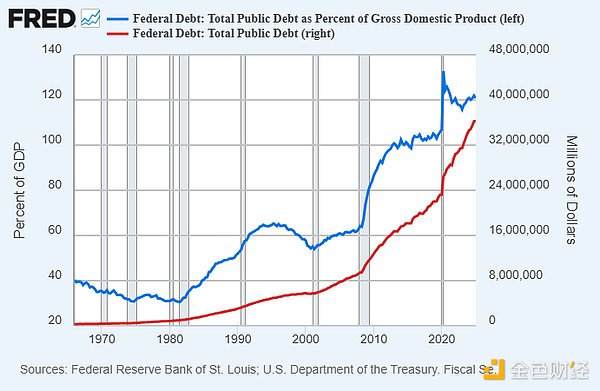
A few weeks ago, I gave a keynote speech on the state of U.S. fiscal debt at a conference in Las Vegas, which was a 20-minute simple summary of the state of U.S. fiscal debt.
As I stated in that speech and have articulated over the years, my point is that the U.S. fiscal deficit will be quite large for the foreseeable future.
Misunderstanding 1: "We owe ourselves"
A common saying promoted by people like Paul Krugman is: "We owe ourselves." Supporters of Modern Monetary Theory often make similar statements, suggesting that the accumulated outstanding debt is mainly just the total surplus allocated to the private sector.
The implication behind this statement is that this debt is not really a big deal. Another potential implication is that we might selectively default on some of the debt because it is just "we owe ourselves." Let's analyze these two parts separately.
Who do we owe?
The federal government owes money to U.S. Treasury bondholders. This includes foreign entities, U.S. institutions, and U.S. individuals. Of course, the amount of Treasury bonds held by these entities is fixed. For example, the dollars owed to the Japanese government are much more than what I owe, even though we both hold Treasury bonds.
If you, I, and eight other people go out to dinner together, we will all end up owing money. If each of us eats different amounts, then the bills we owe may not be the same. The costs usually need to be shared fairly.
In the case of the dinner mentioned above, it is not a big deal because the group is usually friendly, and people are willing to generously cover the costs for others in the gathering. But in a country with 340 million people living in 130 million different households, this is no small matter. If we divide $36 trillion of federal debt by 130 million households, each household's share of federal debt amounts to $277,000. Do you think that is your family's fair share? If not, how do we calculate it?
In other words, if your retirement account has $1 million in Treasury bonds and my retirement account has $100,000 in Treasury bonds, but we are both taxpayers, then while in some sense "we owe ourselves," it is certainly not equal.
In other words, the numbers and proportions do matter. Bondholders expect (often incorrectly) that their bonds will maintain purchasing power. Taxpayers expect (also often incorrectly) that their government will maintain sound fundamentals in its currency, taxation, and spending. This seems obvious, but sometimes it needs to be clarified anyway.
We have a shared ledger, and we have divided the power to manage that ledger. These rules may change over time, but the overall reliability of the ledger is why the world uses it.
Can we selectively default?
Individuals, businesses, and countries can indeed default if the debt owed is denominated in a currency that cannot be printed (such as gold ounces or other currencies) and if there is insufficient cash flow or assets to repay the debt. However, the debt of developed country governments is usually denominated in their own currency and can be printed, so nominal defaults are rare. For them, a simpler method is to print money, devaluing the debt relative to the country's economic output and scarce assets.
Many, including myself, would argue that significant currency devaluation is a form of default. In this sense, the U.S. government defaulted on bondholders in the 1930s by devaluing the dollar against gold, and then again in the 1970s by completely decoupling the dollar from gold. The period of 2020-2021 was also a form of default, as the broad money supply grew by 40% in a short time, and bondholders experienced the worst bear market in over a century, with their purchasing power significantly declining relative to almost all other assets.
But technically, a country can nominally default even if it does not have to. Instead of letting all bondholders and currency holders suffer the pain of devaluation, it might be preferable to default only on unfriendly entities or those capable of bearing the burden, thereby broadly protecting currency holders and non-defaulting bondholders. In such a tense geopolitical environment, this is a possibility worth serious consideration.
So the real question is: Are there certain entities for which the consequences of default are limited?
Some entities would face very serious and obvious consequences if they defaulted:
- If the government defaults on retirees or asset management companies holding Treasury bonds on behalf of retirees, it would undermine their ability to support themselves after a lifetime of work, and we would see elderly people taking to the streets to protest.
- If the government defaults on insurance companies, it would weaken their ability to pay insurance claims, thereby harming American citizens in a similarly bad way.
- If the government defaults on banks, the banks would lose their ability to repay, and consumer bank deposits would not be fully backed by assets.
Of course, most entities (the surviving ones) would refuse to buy Treasury bonds again.
What remains are some more achievable targets. Are there some entities on which the government could default with less damage, and which do not threaten survival like the options mentioned above? The possibilities often lie with foreign companies and the Federal Reserve, so let's analyze them separately.
Analysis: Defaulting on Foreign Debt
Currently, foreign entities hold about $9 trillion in U.S. Treasury bonds, accounting for about a quarter of the total outstanding U.S. debt of $36 trillion.
Of this $9 trillion, about $4 trillion is held by sovereign entities, and $5 trillion is held by foreign private entities.
In recent years, the likelihood of defaulting on specific foreign entities has undoubtedly increased significantly. In the past, the U.S. has frozen sovereign assets in Iran and Afghanistan, but these assets were small and extreme cases, not enough to constitute any "real" default. However, after Russia invaded Ukraine in 2022, the U.S. and its allies in Europe and elsewhere froze over $300 billion in Russian reserves. Freezing is not exactly the same as default (it depends on the ultimate fate of the assets), but it is very close to default.
Since then, foreign central banks have become significant buyers of gold. Gold represents an asset they can hold themselves, thus avoiding default and confiscation, while also being less prone to devaluation.
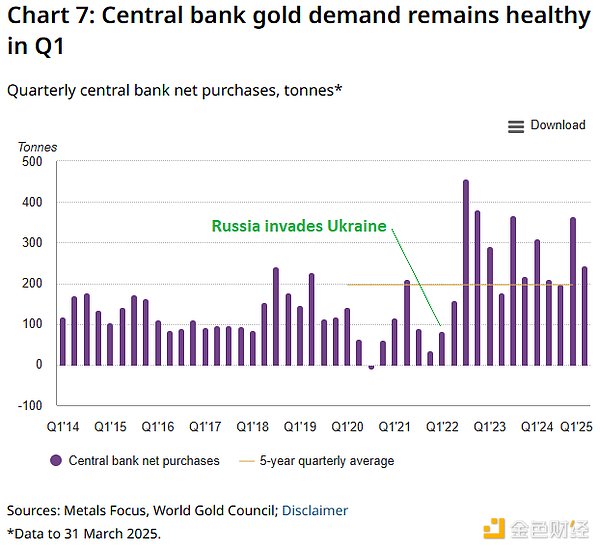
The vast majority of U.S. debt held by foreigners is held by friendly countries and allies. These countries include Japan, the UK, Canada, and others. Some of these countries, such as the Cayman Islands, Luxembourg, Belgium, and Ireland, are tax havens where many institutions set up entities and hold U.S. Treasury bonds. Therefore, some of these foreign holders are actually U.S. entities registered in those places.
China currently holds less than $800 billion in Treasury bonds, which is only equivalent to five months of U.S. deficit spending. They are at the top of the potential "selective default" risk, and they are aware of it.
If the U.S. were to default massively on such entities, it would severely undermine its ability to persuade foreign entities to hold its Treasury bonds long-term. The freezing of Russian reserves has already sent a signal, and countries have reacted to it, but at that time they were doing so under the guise of Russia's "actual invasion." Defaulting on debt held by non-aggressive countries would be seen as a clear default.
Therefore, overall, this is not a particularly viable option, although it is not impossible in certain cases.
Analysis: Federal Reserve Default
Another option is that the Treasury could default on the U.S. Treasury bonds held by the Federal Reserve. Currently, the Federal Reserve holds just over $4 trillion in U.S. Treasury bonds. After all, this is the most fitting way to say "we owe ourselves," right?
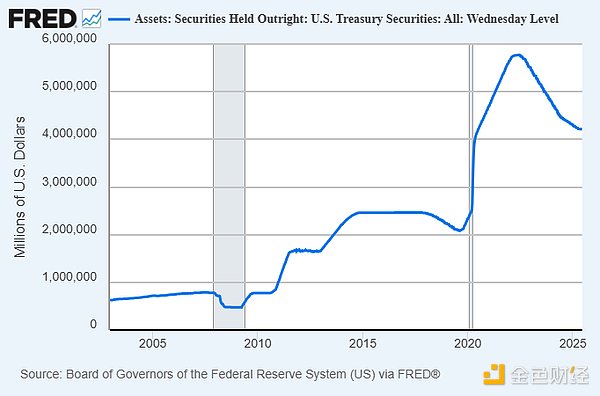
This also presents significant issues.
The Federal Reserve, like any bank, has assets and liabilities. Its main liabilities are 1) physical currency and 2) bank reserves owed to commercial banks. Its main assets are 1) U.S. Treasury bonds and 2) mortgage-backed securities. The Federal Reserve's assets pay it interest, while the Federal Reserve pays interest on bank reserves to set a lower bound on interest rates, suppressing banks' lending incentives and creating more broad money.
Currently, the Federal Reserve is facing massive unrealized losses (hundreds of billions of dollars), with weekly interest payments far exceeding its income. If the Federal Reserve were a regular bank, it would certainly face a bank run and ultimately go bankrupt. But because the Federal Reserve is a central bank, no one can run on it, so it can operate at a loss for a long time. Over the past three years, the Federal Reserve has accumulated net interest losses of over $230 billion:
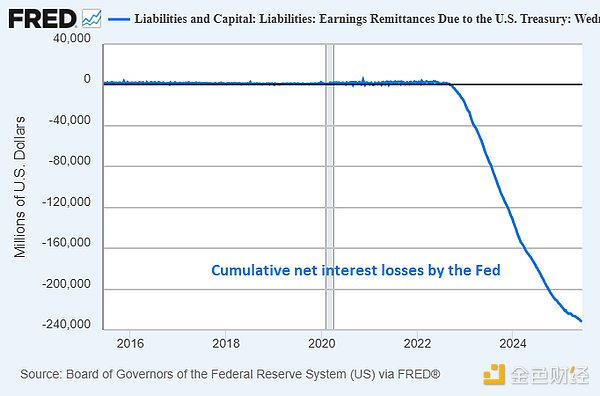
If the Treasury completely defaults on its debt to the Federal Reserve, it would be severely insolvent in real terms (liabilities would exceed assets by trillions of dollars), but as a central bank, it could still avoid a bank run. Their weekly net interest losses would be even greater, as by then they would have lost most of their interest income (since they would only have mortgage-backed securities left).
The main problem with this approach is that it would undermine any notion of central bank independence. Central banks should be fundamentally separated from the executive branch; for example, the president should not be able to lower interest rates before an election and raise them afterward, or engage in similar antics. The president and Congress appoint the Federal Reserve Board and grant it long terms, but since then, the Federal Reserve has had its own budget and is generally expected to be profitable and self-sustaining. A defaulting Federal Reserve is a non-profitable Federal Reserve with massive negative assets. Such a Federal Reserve is no longer independent, and even the illusion of independence is lost.
One potential way to alleviate this issue is to eliminate the interest that the Federal Reserve pays on bank reserves to commercial banks. However, there is a reason for the existence of this interest. It is one of the ways the Federal Reserve sets a lower bound on interest rates in an environment of ample reserves. Congress could legislate to: 1) require banks to hold a certain percentage of assets as reserves; 2) eliminate the Federal Reserve's ability to pay these interest rates to commercial banks. This would shift more problems onto commercial banks.
The latter option is one of the more feasible approaches, with relatively limited consequences. The interests of bank investors (rather than depositors) would be harmed, and the Federal Reserve's ability to influence interest rates and the scale of bank lending would be weakened, but it would not be a disaster overnight. However, the federal deficit held by the Federal Reserve is only equivalent to about two years of federal deficits, accounting for about 12% of the total federal debt, so this somewhat extreme financial repression scheme can only serve as a temporary "band-aid" to alleviate the problem.
In short, we do not owe ourselves. The federal government owes specific entities both domestically and abroad, and defaulting on these debts would result in a series of consequential damages, many of which would, in turn, harm the interests of the federal government and American taxpayers.
Misunderstanding 2: It has been said for decades
Another saying you often hear about debt and deficits is that it has been labeled a problem for decades, and everything has been fine. The implication of this viewpoint is that debt and deficits are not a big deal, and those who think they are important will ultimately just keep "crying wolf" over and over again, and can therefore be safely ignored.
Like many misunderstandings, there is some truth to this.
As I pointed out earlier, the "zeitgeist peak" of the view that federal debt and deficits are a problem can be traced back to the late 1980s and early 1990s. The famous "debt clock" was erected in New York in the late 1980s, and Ross Perot's independent presidential campaign, which was the most successful in modern history (receiving 19% of the popular vote), largely revolved around the theme of debt and deficits. Interest rates were very high at the time, so interest payments accounted for a significant portion of GDP:
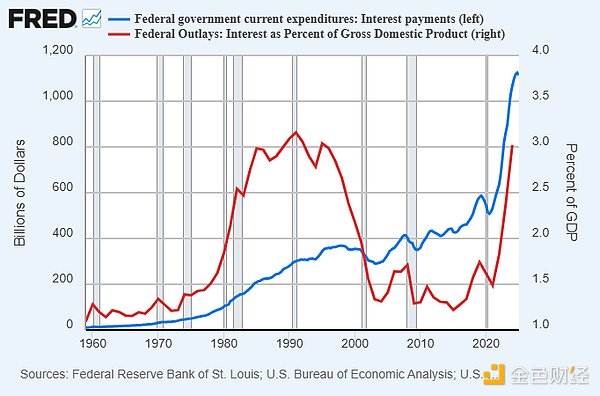
Those who believed that debt would spiral out of control were indeed wrong. For decades, things have been fine. Two main factors contributed to this situation. First, China's opening up in the 1980s and the dissolution of the Soviet Union in the early 1990s had a very serious deflationary impact on the world. A large amount of Eastern labor and resources were integrated with Western capital, bringing a significant new supply of goods to the world. Second, partly due to these factors, interest rates continued to decline, making the interest payments on the growing total debt in the 1990s, early 2000s, and 2010s more manageable.
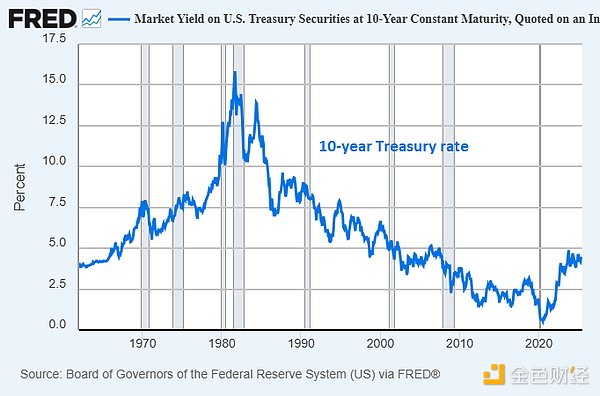
So yes, if someone said 35 years ago that debt was an imminent problem and is still talking about it today, I can understand why some would choose to ignore them.
However, people should not think too far and assume that since this issue has been irrelevant for this period, it will always be irrelevant. This is a fallacy.
By the end of the 2010s, multiple trend changes occurred. Interest rates fell to zero and have not returned to a structurally downward trend since. The baby boomer generation began to retire, leading to Social Security trust funds reaching peak levels and entering a reduction mode. Globalization also reached a potential peak, with the three-decade interconnection between Western capital and Eastern labor/resources essentially coming to an end (and possibly reversing slightly now).
Some trend changes are visualized as follows:
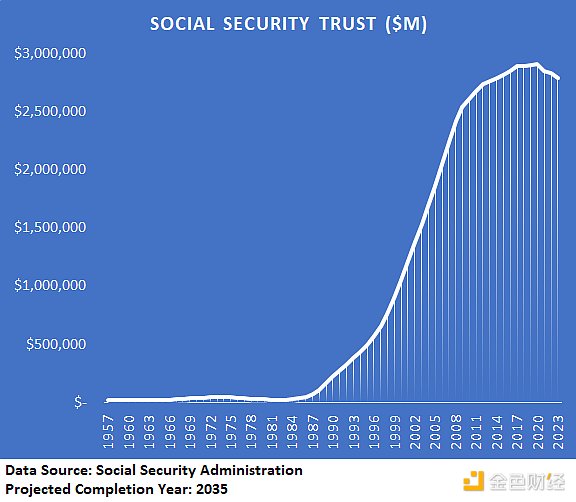
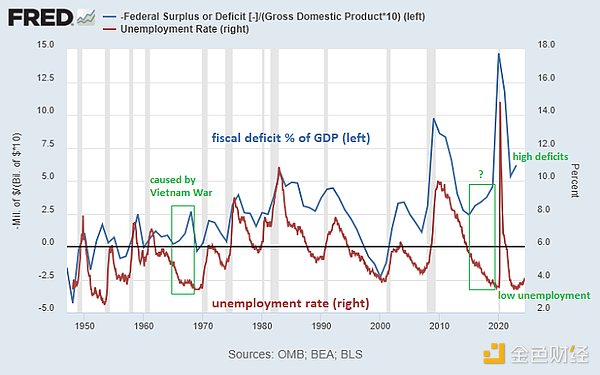
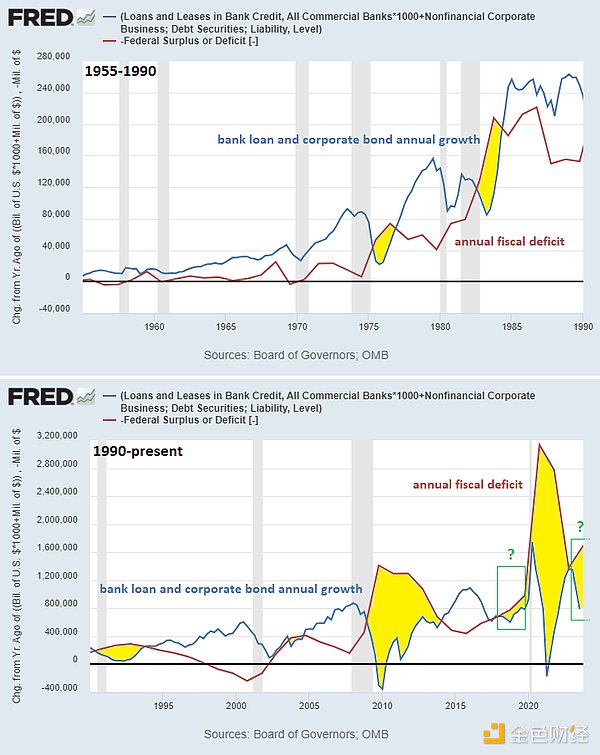

We have not yet reached a point where debt or deficits will trigger a large-scale disaster in the short term. However, we have entered an era where deficits do indeed have impacts and consequences.
For six years, after witnessing the early stages of some trend changes, I have emphasized the increasingly important role of fiscal spending in modern macroeconomics and investment decisions. For years, it has been my main "North Star" as I navigate this rather chaotic macro environment.
Since these trend changes began to occur, taking debt and deficits seriously has been a good way to: 1) not be surprised by some things that have already happened; 2) manage a portfolio more successfully than a typical 60/40 stock/bond allocation.
- My 2019 article "Are We in a Bond Bubble?" serves as a preface to this paper. My conclusion was that yes, we may be in a debt bubble, and the combination of fiscal spending and central bank debt monetization could be more impactful and inflationary than people realize, and this situation is likely to occur in the next economic recession. In early 2020, I wrote "The Subtle Risks of Treasury Bonds," warning that Treasury bonds could be severely devalued. In the 5-6 years since that article was published, the bond market has experienced the worst bear market in over a century.
- In March 2020, at the height of the deflationary shock, I wrote "Why This Is Different from the Great Depression," emphasizing how large-scale fiscal stimulus (i.e., deficits) began and could potentially bring us back to nominal stock market peaks faster than people imagine, although this might come at the cost of high inflation.
Throughout the remainder of 2020, I published a series of articles, such as "Quantitative Easing, Modern Monetary Theory, and Inflation/Deflation," "A Century of Fiscal and Monetary Policy," and "Banks, Quantitative Easing, and Money Printing," exploring why the strong combination of fiscal stimulus and central bank support is fundamentally different from the quantitative easing policies of bank capital restructuring in 2008/2009. In short, my argument is that this is more akin to war financing during the inflationary period of the 1940s rather than the private debt deleveraging of the deflationary 1930s, so holding stocks and hard currencies would be better than holding bonds. As a bond bear, I spent a lot of time debating this topic with bond bulls.
By the spring of 2021, the stock market had risen significantly, and price inflation had indeed begun to explode. My May 2021 newsletter "Fiscal-Driven Inflation" further described and predicted this issue.
In 2022, as prices peaked and the fiscal stimulus measures from the pandemic began to fade, I became quite cautious about fiscal consolidation and the potential recession. My January 2022 newsletter "Capital Sponge" was one of my early frameworks for this scenario. For most of 2022, in terms of broad asset prices, it was indeed a bad year, and the economy slowed significantly, but from most indicators, a recession was avoided due to events that began to unfold later that year.
By the end of 2022, especially in early 2023, the fiscal deficit expanded again, largely due to rapidly rising interest rates inflating public debt interest payments. The Treasury's general account withdrew liquidity from the banking system, and the Treasury turned to issuing excess Treasury bills, a liquidity-friendly move aimed at pulling funds from reverse repurchase agreements back into the banking system. Overall, the expansion of the deficit "reopened hostilities." My July 2023 newsletter titled "Fiscal Dominance" focused on this theme.
- In October 2023, the 2023 federal fiscal year (from October 2022 to September 2023) has ended, and the nominal deficit has increased again. I began this theme with the phrase "Nothing can stop this train" (originally from the TV series "Breaking Bad," but here referring to the U.S. fiscal deficit), and my tweet was as follows:
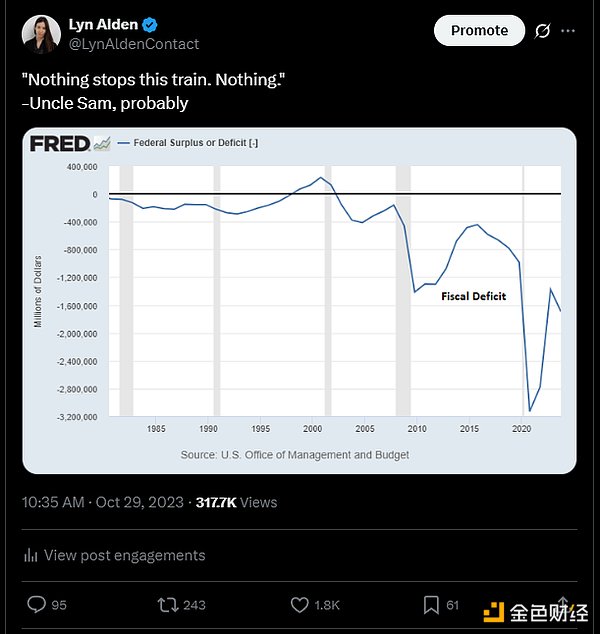
I keep emphasizing this because it effectively conveys the point:
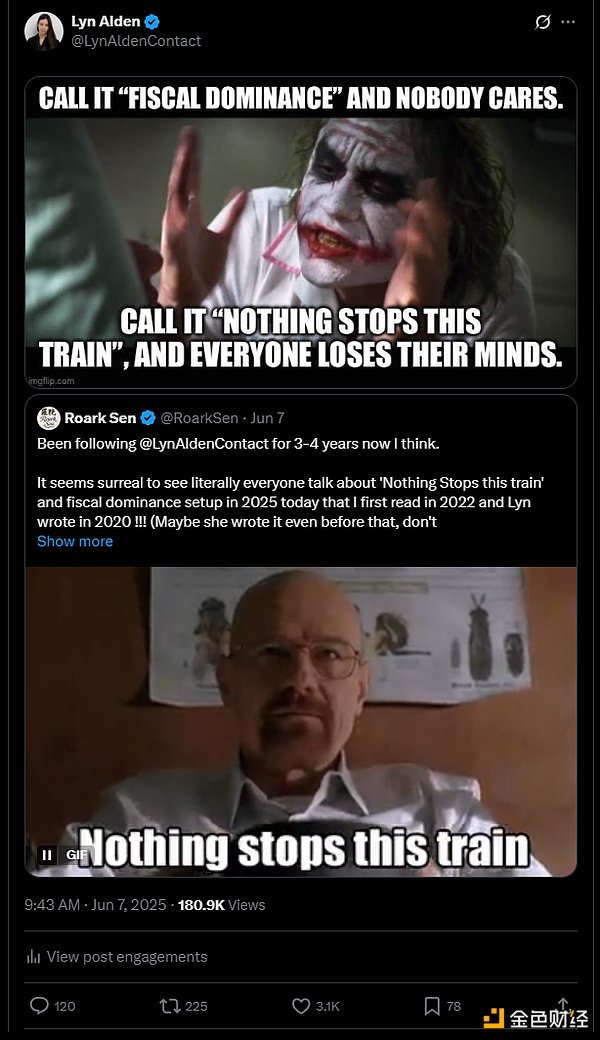
My point is that we are in an era where the total debt and ongoing federal deficits have real impacts. Depending on whether you bear these deficits, you may perceive their effects as positive or negative, but in any case, they will have an impact. These impacts are measurable and reasoned, and therefore will affect the economy and investments.
Misunderstanding 3: The dollar is about to collapse
The first two misunderstandings contradict the general view that debt is unimportant.
The third is somewhat different, as it counters the notion that things will explode tomorrow, next week, next month, or next year.
Those who claim that things will soon explode often fall into two camps. The first camp consists of those who benefit from sensationalism, clickbait, and so on. The second camp consists of those who genuinely misunderstand the situation. Many in the second camp have not conducted in-depth analyses of foreign markets and therefore cannot truly understand the real reasons behind a sovereign bond market collapse.
Currently, the U.S. deficit is about 7% of GDP. As I have pointed out multiple times, this is primarily structural and will be difficult to significantly reduce now or in the next decade. However, a deficit of 70% of GDP is not a problem. Scale matters.
Here are some important metrics to quantify.
- The federal government's debt is slightly over $36 trillion. In comparison, the total assets of U.S. households amount to $180 trillion, with a net worth of $160 trillion after deducting liabilities (mainly mortgages). However, since we do not "owe ourselves," this comparison is somewhat like comparing apples and oranges, but it helps to put the massive numbers in a more concrete context.
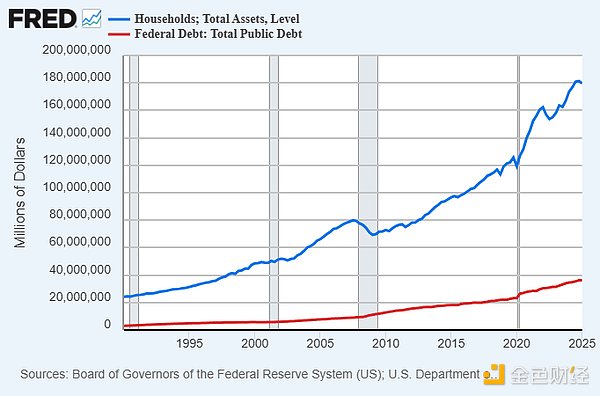
The U.S. monetary base is approximately $6 trillion. The total amount of outstanding dollar-denominated loans and bonds (including both public and private sectors, domestic and international, excluding derivatives) exceeds $120 trillion. In the overseas sector alone, dollar-denominated debt is about $18 trillion, which is three times the existing base dollars.
This means that the demand for dollars, both domestically and internationally, is extremely large and inflexible. All holders of U.S. debt need dollars.
When countries like Turkey or Argentina experience hyperinflation or approach hyperinflation, the backdrop is that almost no one needs their lira or pesos. There is no deep-rooted demand for their currencies. Therefore, if their currencies become unpopular for any reason (usually due to rapid growth in the money supply), it is easy for people to dismiss them and send their value to hell.
The situation with the dollar is not the same. All of this $18 trillion in foreign debt represents a rigid demand for dollars. Most of it is not owed to the U.S. (the U.S. is a net debtor), but foreigners do not "owe themselves" either. Countless specific entities globally owe a certain amount of dollars to countless other specific entities by contract before specific dates, thus requiring constant attempts to acquire dollars.
The fact that the total amount owed in dollars exceeds the existing base dollars is crucial. Because of this, the monetary base can double, triple, or even more without triggering outright hyperinflation. Relative to the contractual demand for dollars, this is still a small increase. When outstanding debt far exceeds the amount of base dollars, a massive printing of base dollars is needed to render that base worthless.
In other words, people seriously underestimate how much the U.S. money supply can grow before triggering a real dollar crisis. It is not difficult to create politically problematic levels of inflation or other issues, but creating a genuine crisis is another matter.
Think of debt and deficits as a dial rather than a switch. Many people ask, "When will it matter?" as if it were a light switch that will go from no problem to disaster. But the answer is that it is usually just a dial. It is already quite important now. We are already operating at full steam. The Federal Reserve's ability to regulate the growth of new credit has been impaired, placing it in a position of fiscal dominance. However, there is still a lot of room for the rest of this dial to turn before it truly reaches its limit.
That is why I use the phrase "Nothing can stop this train." The deficit issue is trickier than the bulls imagine, which means the U.S. federal government is unlikely to get a handle on them in the short term. On the other hand, it is not as imminent as the bears imagine; it is unlikely to trigger a complete dollar crisis in the short term. This is a long and slow train wreck. One pointer is being gradually turned.
Of course, we may encounter a small crisis similar to the UK gilt crisis of 2022. Once it occurs, hundreds of billions of dollars can usually extinguish the fire at the cost of devaluation.
Assuming bond yields soar to the point of causing bank failures or severe liquidity shortages in the U.S. Treasury market, the Federal Reserve could implement quantitative easing or yield suppression measures. Yes, this would come at the cost of potential price inflation and impact asset prices, but in this case, it would not trigger hyperinflation.
In the long run, the dollar will indeed face significant issues. But there are no signs of catastrophic problems in the short term unless we become socially and politically divided (which is unrelated to the data and therefore not within the scope of this article).
Here is some background information. Over the past decade, the U.S. broad money supply has increased by 82%. During the same period, Egypt's broad money supply grew by 638%. The Egyptian pound has also depreciated against the dollar by about 8 times; ten years ago, 1 dollar exchanged for just under 8 Egyptian pounds, while today, 1 dollar exchanges for just over 50 Egyptian pounds. For most of this decade, Egyptians have faced double-digit price inflation.
I spend some time living in Egypt every year. Life there is not easy. They frequently face energy shortages and economic stagnation. But life goes on. Even that level of currency devaluation is not enough to plunge them into a complete crisis, especially with institutions like the International Monetary Fund (IMF) present, which essentially allows them to continue on a path of increasing debt and currency devaluation.
Imagine the cost required to put the dollar in such a position, considering how inflexible the demand for dollars is, let alone a worse situation. When people think the dollar is about to collapse, I usually assume they haven't traveled much or studied other currencies. Things may be much more serious than people imagine, but still partially functional.
More data shows that over the past decade, China's broad money supply has grown by 145%, Brazil by 131%, and India by 183%.
In other words, the dollar will not directly transition from a developed market currency to a collapsing currency. In the process, it must undergo "emerging market syndrome." Foreign demand for dollars may weaken over time. Persistent budget deficits and increasing control over the Federal Reserve may lead to a gradual acceleration in money supply growth and financial repression. Our structural trade deficit gives us monetary vulnerabilities that structural trade surplus countries do not have. But our starting point is developed markets, with deep-rooted global network effects. As conditions worsen, our currency may resemble that of emerging market currencies in many ways. For quite a long time, it may resemble the Brazilian currency, then the Egyptian currency, and then the Turkish currency. It will not leap from the dollar to the Venezuelan bolívar in a year or even five years unless events like a nuclear strike or civil war occur.
In summary, the continuously rising debt and deficit situation in the U.S. is indeed producing increasingly realistic consequences, both now and in the future. It is not as negligible as the "everything is fine" camp claims, nor is it as imminent a disaster as the sensationalist camp suggests. It is likely a tricky issue that will trouble us as a background factor for quite some time, and investors and economists must take this into account to make accurate judgments.
免责声明:本文章仅代表作者个人观点,不代表本平台的立场和观点。本文章仅供信息分享,不构成对任何人的任何投资建议。用户与作者之间的任何争议,与本平台无关。如网页中刊载的文章或图片涉及侵权,请提供相关的权利证明和身份证明发送邮件到support@aicoin.com,本平台相关工作人员将会进行核查。




